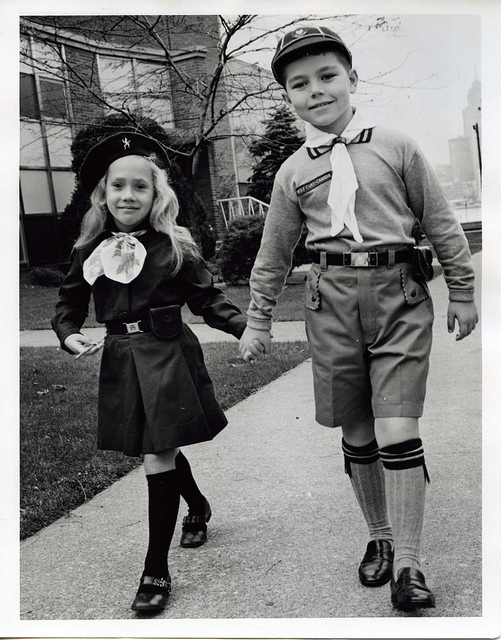This November, a century-old friendship between American youth institutions was shattered in a federal lawsuit. In a bitter break to a historic partnership, the Girl Scouts sued the Boy Scouts after the Boy Scouts announced that it would begin admitting girls into its ranks and become a coeducational program. Situated within an evolving culture and society, especially surrounding gender and LGBTQ rights, becoming coed marks a cultural adaptation for the Boy Scouts that is surprising to those who know the institution’s history of gender exclusion. This shift to coeducation represents a larger trend of declining single sex programs in the U.S. and the world, exemplified by the demise of women’s colleges, and the coed transformation of the Boy Scouts. The Girl Scouts should recognize that their sector, female-specifc educational programs, will continue to shrink as coeducation rises, while maintaining its mission and supporting female leadership empowerment. The inevitable shift towards coeducation undermines the empowering aspects of single-sex programs in America and necessitates that we address gender issues within coed programs while acknowledging and affirming the ongoing need for and benefits of single sex programs.
The Boy Scouts’ change to admit girls comes as the program desperately attempts to increase its membership after years of decline. Five decades ago, at the program’s peak, the Boy Scouts boasted a membership of around 4 million boys; membership today hovers around a comparatively paltry 2.3 million. Supporters of the change argue that this will allow for more inclusion and laude the Boy Scouts for modernizing with a goal of equality.
Opponents, especially the Girl Scouts, believe that the Boy Scouts are “infringing on its trademark, engaging in unfair competition, and causing ‘an extraordinary level of confusion among the public.’” On top of the purported trademark infringement, Girl Scout leaders believe that the most important aspect of the Girl Scouts is that it is explicitly girl-led and girl-empowering. The organization emphasizes inclusion, volunteerism, civic duty, and career growth. Unsurprisingly, some of our most influential female leaders, like Hillary Clinton, Sandra Day O’Connor, Condoleezza Rice, Taylor Swift, Venus Williams, and Barbara Walters, are among its over 50 million alumnae. Girl Scouts supporters fear that the rebranding of the Boy Scouts will erode the Girl Scout’s programs and inevitably disadvantage the female-centered, female-led power of their program.
The Girl Scouts was created in 1912 to counter the exclusion of girls from the Boy Scouts of America, which was started two years earlier. The founder of the Girl Scouts, Juliette Gordon Low, began the organization with a clear and confident mission to empower girls. Although the Girl Scouts were trained in some traditional domestic arts and home skills, they also were empowered to try more “masculine” activities. From Low’s vision in the early 20th century, the Girl Scouts has grown into an incredible movement in the US that provides intensive leadership training to girls that were previously excluded. Dan White writes of the Boy Scouts in the Washington Post, saying that “the same group that is now opening its doors so enthusiastically to female members once accused Low of turning girls into tomboys and invading the territory of men.” A look at the history and variance between the Boy and Girl Scouts elucidates the roles both organizations have played in training America’s youth. Within the historical context of exclusion and segregation that inspired the very creation of the Girl Scouts, the Boy Scouts’ move to become gender inclusive seems like too little too late, with potentially deleterious effects for the empowering Girl Scouts.
In recent years, the Boy Scouts of America has significantly altered the outdated practices surrounding gender that defined its role in historical America. It has loosened its membership requirements in a host of changes intent on modernizing. In 2013, the group lifted a ban on openly gay members. In 2015, it stopped barring gay scout leaders. Most recently, in January 2017, it began accepting transgender members. Clearly, the organization has been struggling to adapt to a modern culture that praises inclusivity and fluidity in gender.
The trend towards coeducation and the subsequent decline in single-sex programs and institutions brings into question the role of gender in coed environments. Research suggests that coeducation within scouting may mean fewer opportunities for girls, social pressures resulting in diminished confidence, and more girls taking secondary rather than leadership roles. The decline in single-sex extracurriculars parallels a simultaneous decline in single sex education and colleges. Kier Feldman writes in the New York Times that women’s colleges today “are at a crossroads their founders could never have foreseen, struggling to reconcile their mission with a growing societal shift on how gender itself is defined.” The debate over gender’s role in education provides an analogous framework to understand the Girl Scouts’ lawsuit. A recent survey showed that girls in single-sex schools are four times more likely to choose Physics in the absence of strict gender stereotypes. Historically created to serve women who were excluded from all-male education, women’s colleges serve less of a clearly delineated purpose today and are dwindling accordingly.
Regardless of the justness, morality, or benefits of having single sex programs, as understanding of gender fluidity increases and societal norms shift, the recent trend towards coeducation will continue. The Girl Scouts should continue fulfilling their mission and their vision, with a heightened awareness for the rise of coeducation, by focusing on young women and girls, bolstering their voices through Girl Scouts activities and lessons, and increasing more opportunities traditionally characterized as “masculine.” However, as the fall of single sex programs continues in the US, we as a society and as educators must adjust, reinforce, and strengthen our coed programs by learning from where the Girl Scouts and women colleges have succeeded. By acknowledging the flaws in coeducation that disproportionately hurt girls—like less exposure to STEM fields and less leadership opportunities—we can build up opportunities and initiatives for girls and women within gender inclusive organizations and change curricula that perpetuate known inadequacies.
Photo: Brownie and Boy Scout
